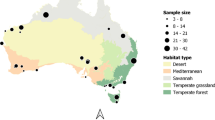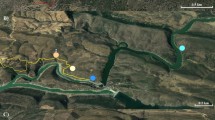Abstract
A number of primate census techniques have been developed over the past half-century, each of which have advantages and disadvantages in terms of resources required by researchers (e.g., time and costs), availability of technologies, and effectiveness in different habitat types. This study aims to explore the effectiveness of a thermal imaging technique to estimate the group size of different primate species populations in a degraded riparian forest in the Lower Kinabatangan Wildlife Sanctuary (LKWS), Sabah. We compared this survey technique to the conventional visual counting method along the riverbank. For 38 days, a total of 138 primate groups were observed by thermal camera and visually throughout the study. Optimal conditions for the thermal camera were clear weather, not more than 100 m distance from the observer to the targeted area, boat speed ranging between 5 and 12 km/h, and early morning between 04:30 and 05:30 am. The limitations of the thermal cameras include the inability to identify individual species, sexes, age classes, and also to discern between animals closely aggregated (i.e., mothers with attached infants). Despite these limitations with the thermal camera technique, 1.78 times more primates were detected than counting by eye (p < 0.001), showing the potential benefit of using thermal cameras as an important tool in primate surveys. Nevertheless, ground truthing must be conducted immediately after, or simultaneously during, the thermal survey to verify the species of animals observed on the thermal imagery.



Similar content being viewed by others
References
Bernard H, Bili R, Matsuda I, Hanya G, Wearn OR, Wong A, Ahmad AH (2016) Species richness and distribution of primates in disturbed and converted forest landscapes in northern Borneo. Trop Conserv Sci 9(4):1–11
Burke C, Rashman M, Longmore S, McAree O, Glover-Kapfer P, Ancrenaz M, Wich S (2019) Successful observation of orangutans in the wild with thermal-equipped drones. J Unmanned Veh Syst. https://doi.org/10.1139/juvs-2018-0035
Burn DM, Udevitz MS, Speckman SG, Benter RB (2009) An improved procedure for detection and enumeration of walrus signatures in airborne thermal imagery. Int J Appl Earth Obs Geoinf 11(2009):324–333
Chapman CA, Bortolamiol S, Matsuda I, Omeja PA, Paim FP, Reyna-Hurtado R, Sengupta R, Valenta K (2017) Primate population dynamics: variation in abundance over space and time. Biodivers Conserv 27:1221–1238. https://doi.org/10.1007/s10531-017-1489-3
Chretien LP, Theau J, Menard P (2015) Wildlife multispecies remote sensing using visible and thermal infrared imagery acquired from an unmanned aerial vehicle (UAV). Int Arch Photogramm Remote Sens Spat Inf Sci XL-4/W4:241–247
Cilulko J, Janiszewski P, Bogdaszewski M, Szczygielska E (2013) Infrared thermal imaging in studies of wild animals. Eur J Wildl Res 59:17–23
Collier BA, Ditchkoff SS, Raglin JB, Smith JM (2007) Detection probability and sources of variation in white-tailed deer spotlight surveys. J Wildl Manag 71(1):277–281
Daniels MJ (2006) Estimating red deer Cerphus elaphus populations: an analysis of variation and cost-effectiveness of counting methods. Mamm Rev 36:235–247
Ditchkoff SS, Raglin JB, Smith JM, Collier BA (2005) From the field: capture of white-tailed deer fawns using thermal imaging technology. Wildl Soc Bull 33(3):1164–1168
Franke U, Goll B, Hohmann U, Heurich M (2012) Aerial ungulate surveys with a combination of infrared and high-resolution natural colour images. Anim Biodivers Conserv 35(2):284–293
Garner DL, Underwood HB, Porter WF (1995) Use of modern infrared thermography for wildlife population surveys. Environ Manag 119(2):233–238
Gauthreaux SA Jr, Livingston JW (2006) Monitoring bird migration with a fixed-beam radar and a thermal imaging camera. J Field Ornithol 77(3):319–328
Gooday OJ, Key N, Goldstien S, Zawar-Reza P (2018) An assessment of thermal-image acquisition with an unmanned aerial vehicle (UAV) for direct counts of coastal marine mammals ashore. J Unmanned Veh Syst 6(2):100–108
Gowen AA, Tiwari BK, Cullen PJ, McDonnel K, O’Donnell CP (2010) Applications of thermal imaging in food quality and safety assessment. Trends Food Sci Technol. https://doi.org/10.1016/j.tifs.2009.12.002
Graves HB, Bellis ED, Knuth WM (1972) Censusing white-tailed deer by airborne thermal infrared imagery. J Wildl Manag 36:875–884
Havens K, Sharp E (1998) Using thermal survey imagery in the aerial survey of animals. Wildl Soc Bull 26(1):17–23
Ingberman B, Fusco-Costa R, Monteiro-Filho E (2009) Population survey and demographic features of a coastal island population of Alouatta clamitans in Atlantic forest, Southeastern Brazil. Int J Primatol 30:1–14. https://doi.org/10.1007/s10764-008-9324-z
Ishimwe R, Abutaleb K, Ahmed F (2014) Application of thermal imaging in agriculture—a review. Adv Remote Sens 3:128–140
Kays R, Sheppard J, Mclean K, Welch C, Paunescu C, Wang V, Kravit G, Crofoot M (2018) Hot monkey, cold reality: surveying rainforest canopy mammals using drone-mounted thermal infrared sensors. Int J Remote Sens. https://doi.org/10.1080/01431161.2018.1523580
Lavers C, Franklin P, Franklin P, Plowman A, Sayers G, Bol J, Shepard D, Fields D (2009) Non-destructive high-resolution thermal imaging techniques to evaluate wildlife and delicate biological samples. J Phys Conf Ser 178:012040
Matsuda I, Tuuga A, Higashi S (2010) Effects of water level on sleeping-site selection and inter-group association in proboscis monkeys: why do they sleep alone inland on flooded days? Ecol Res 25:475–482. https://doi.org/10.1007/s11284-009-0677-3
Matsuda I, Tuuga A, Bernard H (2011) Riverine refuging by proboscis monkeys (Nasalis larvatus) and sympatric primates: implications for adaptive benefits of the riverine habitat. Mamm Biol 76:165–171. https://doi.org/10.1016/j.mambio.2010.03.005v
Matsuda I, Otani Y, Bernard H, Wong A, Tuuga A (2016) Primate survey in a Bornean flooded forest: evaluation of best approach and best timing. Mamm Study 41:101–106
Mitchell WF, Clarke RH (2019) Using infrared thermography to detect night-roosting birds. J Field Ornithol 90(1):39–51
Mulero-Pazmany M, Stopler R, van Essen LD, Negro JJ, Sassen T (2014) Remotely piloted aircraft systems as a rhinoceros anti-poaching tool in Africa. PLoS ONE 9(1):e83873. https://doi.org/10.1371/journal.pone.0083873
Payne J, Francis CM, Phillips K (1985) A field guide to the mammals of Borneo. Kota Kinabalu: The Sabah Society and World Wildlife Fund Malaysia
Plumptre AJ, Cox D (2006) Counting primates for conservation: primate surveys in Uganda. Primate 47(1):65–73
Plumptre AJ, Sterling EJ, Buckland ST (2013) Primate ecology and conservation: primate census and survey techniques. Oxford University Press, p 26. https://www.researchgate.net/publication/242019163_Primate_census_and_survey_techniques
Rao P (2008) Infrared thermography and its applications to civil engineering. Indian Concr J 82(5):41–50
Ring EFJ, Ammer K (2012) Infrared thermal imaging in medicine. Physiol Meas 33(2012):R33–R46
Spaan D, Burke C, McAree O, Aureli F, Rangel-Rivera CE, Hutschenreiter A, Longmore SN, McWhirter PR, Wich SA (2019) Thermal infrared imaging from drones offers a major advance for spider monkey surveys. Drones 3:34
Acknowledgements
The authors acknowledge the Medical Research Council, Natural Environmental Research Council, Economic and Social Research Council and Biotechnology and Biosciences Research Council for the funding received for this project through the Environmental and Social Ecology of Human Infectious Diseases Initiative (ESEI). Grant number: G1100796. The authors also acknowledge Danau Girang Field Centre (DGFC), and Universiti Malaysia Sabah (UMS), UMS Great grant number: GUG0055-STWN-2/2016 for the funding received for this project. We also thank the students, volunteers, and research assistants from Danau Girang Field Centre for helping with data collection.
Author information
Authors and Affiliations
Corresponding author
Additional information
Publisher's Note
Springer Nature remains neutral with regard to jurisdictional claims in published maps and institutional affiliations.
Electronic supplementary material
Below is the link to the electronic supplementary material.
About this article
Cite this article
Jumail, A., Liew, TS., Salgado-Lynn, M. et al. A comparative evaluation of thermal camera and visual counting methods for primate census in a riparian forest at the Lower Kinabatangan Wildlife Sanctuary (LKWS), Malaysian Borneo. Primates 62, 143–151 (2021). https://doi.org/10.1007/s10329-020-00837-y
Received:
Accepted:
Published:
Issue Date:
DOI: https://doi.org/10.1007/s10329-020-00837-y




